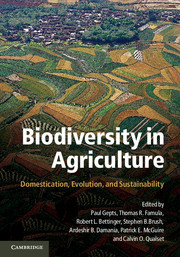Book contents
- Frontmatter
- Contents
- Tables
- Figures
- Foreword
- Contributors
- Acknowledgments
- Introduction: The Domestication of Plants and Animals: Ten Unanswered Questions
- 1 The Local Origins of Domestication
- Section I Early Steps in Agricultural Domestication
- Section II Domestication of Animals and Impacts on Humans
- Section III Issues in Plant Domestication
- 13 The Dynamics of Rice Domestication: A Balance between Gene Flow and Genetic Isolation
- 14 Domestication of Lima Beans: A New Look at an Old Problem
- 15 Genetic Characterization of Cassava (Manihot esculenta Crantz) and Yam (Dioscorea trifida L.) Landraces in Swidden Agriculture Systems in Brazil
- 16 Pigeonpea: From an Orphan to a Leader in Food Legumes
- Section IV Traditional Management of Biodiversity
- Section V Uses of Biodiversity and New and Future Domestications
- Index
- References
13 - The Dynamics of Rice Domestication: A Balance between Gene Flow and Genetic Isolation
Published online by Cambridge University Press: 05 June 2012
- Frontmatter
- Contents
- Tables
- Figures
- Foreword
- Contributors
- Acknowledgments
- Introduction: The Domestication of Plants and Animals: Ten Unanswered Questions
- 1 The Local Origins of Domestication
- Section I Early Steps in Agricultural Domestication
- Section II Domestication of Animals and Impacts on Humans
- Section III Issues in Plant Domestication
- 13 The Dynamics of Rice Domestication: A Balance between Gene Flow and Genetic Isolation
- 14 Domestication of Lima Beans: A New Look at an Old Problem
- 15 Genetic Characterization of Cassava (Manihot esculenta Crantz) and Yam (Dioscorea trifida L.) Landraces in Swidden Agriculture Systems in Brazil
- 16 Pigeonpea: From an Orphan to a Leader in Food Legumes
- Section IV Traditional Management of Biodiversity
- Section V Uses of Biodiversity and New and Future Domestications
- Index
- References
Summary
The relationship between domesticated crop species and their wild ancestors has fascinated geneticists and evolutionists for over 150 years (Darwin 1859, 1868). Over the past century, growing awareness of the value of plant genetic diversity has led to global efforts to preserve genetic resources (Vavilov 1926, Plucknett et al. 1983, Chang 1984, Plucknett 1987, Harlan 1992). More recently, tools for investigating genetic diversity and evolution at the molecular level have provided new opportunities to investigate the process of crop domestication and to more efficiently utilize natural variation in crop improvement (Tanksley and McCouch 1997, Hoisington et al. 1999, Wing et al. 2005, Doebley et al. 2006, Dubcovsky and Dvorak 2007, Johal et al. 2008).
Domestication
Over the course of domestication, plant species undergo a series of profound phenotypic changes that result from human selection on diverse, wild populations. The genetic changes responsible for the suite of traits that differentiate domesticated plants from their wild ancestors are referred to as the “domestication syndrome” (Hammer 1984). These may include nondehiscence or nonshattering (lack of seed dispersal at maturity), more compact growth habit, reduction in seed dormancy, enhanced size and yield of edible plant parts, reduced toxicity, and changes in the reproductive system, generally toward increased rates of self-pollination or vegetative propagation (Simmonds 1979, Gepts 2004). Plants may be cultivated for hundreds or thousands of years before they are domesticated; until a plant has been modified to the extent that it can no longer survive without human intervention in its natural environment, it is not considered completely domesticated. The domestication of plants and animals had a profound impact on the structure and interactions of human societies. Most notably, humans transitioned from hunting–gathering to agriculture as the main form of food acquisition, allowing them to live sedentary lives and introducing the potential for food surpluses, population expansion, occupational specialization, and social stratification.
- Type
- Chapter
- Information
- Biodiversity in AgricultureDomestication, Evolution, and Sustainability, pp. 311 - 329Publisher: Cambridge University PressPrint publication year: 2012
References
- 4
- Cited by



